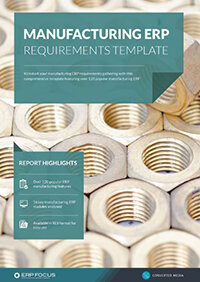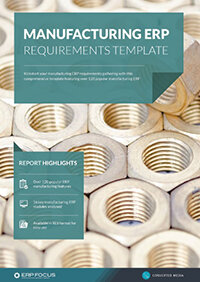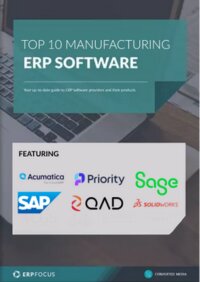Sales demand forecasting and ERP
Companies need to forecast sales for two main reasons: first, to validate their medium- and long-term business plans. Both manufacturing and distribution companies require a minimum number and value of orders to stay viable. If these orders aren’t expected, it's important to know in advance to consider options like introducing new products or entering new markets.
The second reason is that sales increases will impact a company's resources. When a manufacturing company expects higher sales, it may need to plan a new plant in advance, as commissioning machines and training staff takes time. A distribution company might need extra warehouse space and staff, while suppliers may require time to increase production. Conversely, if sales are expected to decrease and cannot be addressed in time, reducing staff and facilities in a planned manner may minimize costs for all involved.
Demand forecasting solutions and challenges
The problem is that forecasting sales accurately has always been viewed as a difficult thing to do, particularly along complex supply chains. While ERP forecasting tools and demand forecasting solutions exist, most companies have believed them to be either hideously expensive or, in an attempt to keep the cost down, too simple to be of any real use.
Until relatively recently, they were right. But nowadays good, cheap and effective solutions are available, some via the cloud, to link seamlessly with ERP systems to extract data, process it and push forecasts back in.
Manufacturing companies have challenges, but also opportunities, that distribution companies do not. Not only might they need to forecast demand at the sellable item level (product or SKU) but they may also need to, or benefit from, forecasting at one or both of the raw materials and intermediate (sub-assembly) levels.
One of the difficulties some companies encounter in sales forecasting is managing the sheer number of products or product variants they sell. Generating useful forecasts for potentially thousands of products can be impractical, and the fact that some items only sell in small quantities adds to the complexity. ERP forecasting tools and systems with planning bills of materials are designed to address this issue.
Forecasting tools and the Law of Big Numbers
Planning bills use what we might call “The Law of Big Numbers.” Large numbers are inherently easier to estimate. For example, imagine a car manufacturer offering a particular model with several customizable options. They may not know how many 1.6-liter, four-door cars in red with grey upholstery they will sell next week, but they can estimate the total number of cars sold and use past experience to determine that:
20% of the cars sold use the 1.6-liter engine,
45% the 2.0-liter engine,
35% the diesel engine, and so on.
If they create a composite (planning) bill of material that reflects those percentages, and then feed in a forecast at the model level of, say 10,000 cars, the MRP system will tell them that they need:
- 10,000 x 20% = 2,000 1.6 litre petrol engines
- 10,000 x 65% = 6,500 2.0 litre petrol engines
- 10,000 x 15% = 1,500 1.9 litre diesel engines
- 10,000 x 20% = 2,000 2-door body shells
- 10,000 x 65% = 6,500 4-door body shells
- 10,000 x 15% = 1,500 station wagon body shells, etc.
While they won't manufacture fractional engines or body shells, this approach ensures they have provisioned materials that will likely meet production demand. This method of shifting ERP forecasting to a higher level helps companies achieve more reliable results by working with larger numbers.
This car example illustrates the principle, but it has been applied across industries such as furniture and PC manufacturing. Companies with subassemblies used in various end products can benefit from this approach. The key to successful demand forecasting solutions in manufacturing often lies in recognizing that forecasting at the finished item level isn't always necessary.
Advanced demand forecasting solutions in manufacturing
Some manufacturers take this further. Forecasting sales at an intermediate or subassembly level can also open the door to stocking at that level, which offers significant advantages. For make-to-order companies, holding stock at the subassembly level rather than just raw materials can drastically reduce manufacturing lead times, enabling them to offer shorter delivery times to customers.
For those that make-to-stock it can remove the frustration of looking in the finished goods warehouse and seeing urgently needed subassemblies that have been built into items for which there are no orders. It's not always physically possible to disassemble unwanted stock to rob components for high priority orders, even if the required labor can be made available.
Some ERP vendors will say that their systems don't offer planning bills of material, or that holding stocks of things like engines to 2 decimal places is simply too awkward, but a very simple and effective workaround is available when systems don't have this ability.
Using the car example again: a company can set up a part number to describe the model range and give that part number a unit of measure of, say, thousands. Then the bill of material says that to make one thousand cars, two hundred 1.6 litre pertol engines, 650 2.0 litre petrol engines, 150 1.9 litre diesel engines etc are needed and, as long as the forecast is entered in thousands, the system will work just as well.
When using these techniques to generate better sales forecasts, the full power of the MRP element of a company's ERP system can be let loose and the effect will be well worth the effort.
Free white paper

Manufacturing ERP requirements template
Over 120 critical manufacturing ERP features in one downloadable spreadsheet

Featured white papers
Related articles
-

4 training tips for manufacturing ERP success
These four training tips will help your employees get the most out of your new manufacturing ERP ...
-

CMMC Compliance: What Aerospace and Defense Manufacturers Need to Know
Key insights on CMMC compliance, deadlines, and securing DoD contracts with CMMC 2.0 certificatio...
-

ERP for make-to-order manufacturing
How can ERP help your make-to-order manufacturing business thrive?




